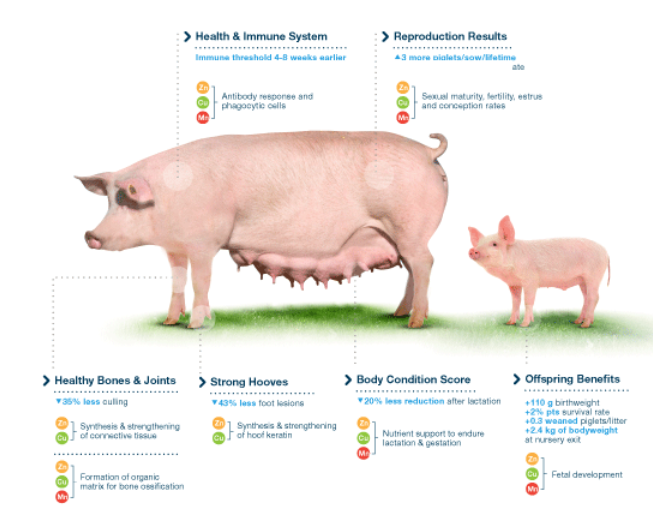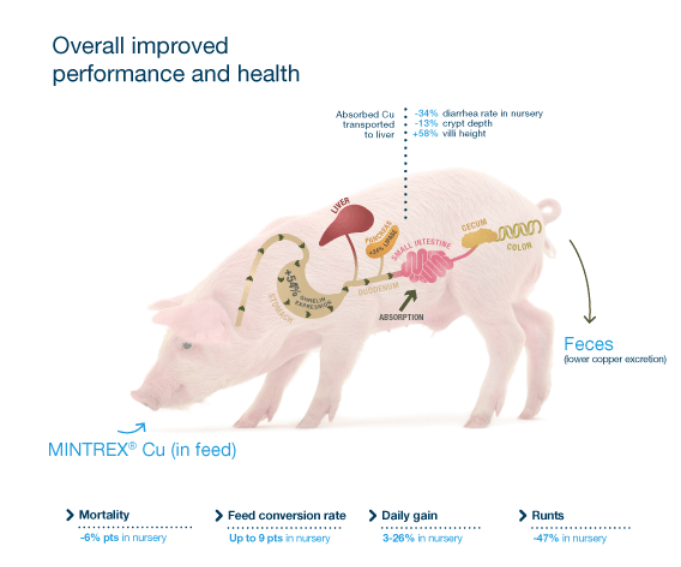



Organic trace minerals equip sows and piglets for profitable performance
Not all mineral sources are the same. For more successful sows and high-performing piglets, many producers have turned to chelated organic trace minerals instead of inorganic options.For more successful sows and high-performing piglets, many producers have turned to chelated organic trace minerals instead of inorganic options to improve litter size, birthweight and overall end results, with the goal of creating heavier and healthier piglets and well-nourished sows that will remain profitable for more parities.
Increased Sow Parity Success and Reduced Replacement Rates
While piglet productivity is vital to profitability and often the focus of mineral supplementation, the impactful results procured from sow supplementation could be wrongly overlooked. Repeatedly high sow replacement rates can be devastating to a producer. Reproductive failure and locomotion problems are consistent issues, and they have the greatest impact on removal rates. Sows fed Mintrex® trace minerals, however, were found to be better equipped for gestation and lactation, reducing sow removal rates significantly in recent studies. Reductions in removal rates for locomotion as high as 35 percent were recorded in a recent study shared by Novus (Zhao et al., 2012). As a result, it has been estimated that sows fed Mintrex will produce three more piglets per lifetime due to to the wide-ranging effects of the supplement (Figure 1).
Figure 1: Mintrex Effects on Sow Health and Productivity

The effects of supplementing sows with organic trace minerals can even be filtered down to the next generation. Research has demonstrated that the progeny from sows fed Mintrex showed better growth rates than those of sows fed inorganics. The piglets’ bodyweight advantage from birth is carried on throughout their lifetime, while also increasing piglet performance during the vital post-weaning period considerably.
Improved Piglet Health and Productivity
At weaning, piglets experience a sharp drop in feed intake and growth, which has detrimental effects on their overall development. During this phase, inclusion of a highly bioavailable source of copper in the diet can exert a positive effect to overcome this depression. Research trials demonstrated that the addition of Mintrex® Cu to nursery diets promoted piglet growth by improving bodyweight gain and feed-to-gain ratios (Esquerra, 2014).
Figure 2: Piglet Performance and Health Improved with Trace Minerals

A key component of combating any post-weaning declines in productivity is the piglet’s gut health management. A healthy intestine has proper barrier function against pathogens and high villi and low crypt depth that provide vast surface area for digestion and absorption of nutrients. During post-weaning, the piglet gut is exposed to several challenges causing its barrier function against pathogens to fail and poor nutrient absorption. Altogether, this causes pathogenic bacterial overgrowth and clinical consequences, such as diarrhoea, immunity suppression, poor growth performance and mortality. Providing piglets with a highly bioavailable source of copper can help to minimise these symptoms. Trials with Mintrex Cu have shown sharp reductions in mortality, 13 percent reductions of crypt depth and 58 percent increases of villi height compared with inorganic sources (Chen et al., 2016; P<0.05).
Equipping piglets for optimal growth and improving sow retention and productivity is a shared goal by pig producers around the globe. Utilising organic trace minerals, along with careful management, could bring significant increases in pig and sow productivity, and ultimately help improve profitability.
For more information on Mintrex sold by Novus International visit http://www.novusint.com/en-gb/Products/mintrex.








